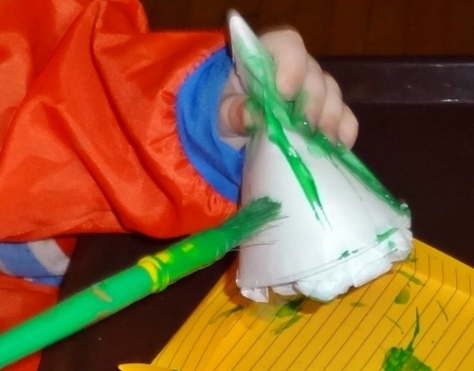I’m not sure exactly when I went anti-craft but at some point I began to despise product crafts. Maybe it was the year I volunteered in my son’s Kindergarten class when I spent hours cutting out pieces for the children to assemble according to the prescribed pattern. Maybe it was after I opened my childcare home and watched a steady procession of elementary school children bringing back exactly the same craft products year after year after year.
Over the past fifteen or so years I’ve rarely provided any sort of art/craft instruction and never insisted everyone had to participate. I’ve taken a ‘loose parts’ approach to setting up the art area and the children are able to choose to use the art supplies freely throughout the day to create whatever interests them.
I’ve watched some children create really amazing art work. They have wonderful imaginations and problem solving skills. If there is something missing from the art area that they think would benefit their projects they ask for it or bring it from home. Some of these expert artists also enjoy assisting others and will lead spontaneous art classes.
I’ve also observed children who struggle with an open-ended art area. Some don’t know how to start if there isn’t a leader showing the way. Some are easily frustrated and give up mid project. Some never set foot in the art area either because they are not interested or because they doubt their own ability. There are even some for whom the ‘product’ is so important that they will send the ‘artists’ to make things for them but never attempt to create their own.
Sometimes there isn’t a lead artist in the group – there may be one or two that are very creative but they are ‘followers’. Even though they can create imaginative artwork when working independently, if another child is present they just imitate each other. Often there isn’t even any art, just play with the art materials – pencil swords, rolled paper trumpets, etc. Groups like this rarely have any ‘products’ and the few they do have are exactly the same three pencil lines on a crumpled piece of paper day after day.
Some art tools, like scissors, are more like ‘weapons of mass destruction’. Sure I think scissors skills are important but I’m not entirely certain scissors are a ‘creative’ tool that I want all preschoolers to have free independent access to.
I’ve tried to limit my ‘instruction’ to introducing new supplies – demonstrating methods and techniques – not products. Invariably there will be at least one child who will simply copy everything I do and others who will follow along. *sigh* We have now created what looks like a product craft.
I think there has to be a middle ground – at least for preschoolers. Not just ‘follow my instructions and make this’ product crafts. Not just ‘here are some materials, play with them’ entirely child led process. So, here are a few things we’ve done recently;
Tissue paper, paper plates & glue: ripping, crumpling, flattening, spreading, pouring, pressing and more – a lot of different ‘process’ yet the ‘products’ all looked pretty similar in the end.


Clay, water, tools, sand, glue – several steps on/off throughout a week long experience – many differences along the way yet very similar in the end.




Paper cones, paint, glitter, clay and sticks;



Yes, there were a lot of new experiences, a lot of process, some instruction, a lot of imitation – trying what someone else did and liking it, and even some ‘product’. I think the important thing was there was no ‘correction’ – no, ‘that’s not what you are supposed to be making, fix it’. If they wanted to make something different they could – and some did – briefly – then they scrapped it and copied what the others were doing because that is what they do. That is what they like to do – most of them – at least in this group – but if they didn’t want to that would have been OK too.

No comments:
Post a Comment